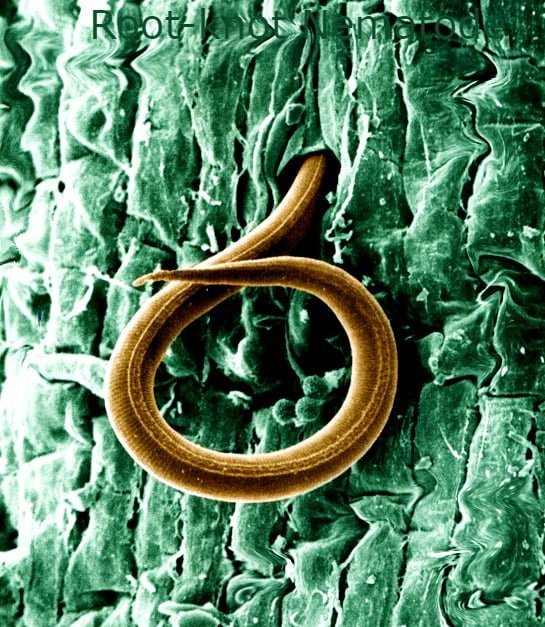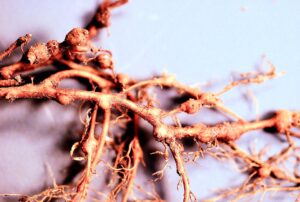Citrus Nematode
One of the most significant problems that might arise when growing citrus is the citrus nematode. Lemon plants all across the world have been afflicted by a pathogen called a citrus nematode. Citrus orchids experience a gradual deterioration as a result of nematode infestation. The citrus nematode disease was initially discovered in Asia, and then it spread to the United States, India, Australia, China, Brazil, Mexico, and the rest of the world via plants that were infected with the disease.
What is Nematode

Nematoda (also known as Nemathelminthes) is the phylum that contains nematodes, some of which are plant-parasitic eelworms. This animal phylum inhabits a vast array of habitat types. Taxonomically, they belong to the genus Ecdysozoa, which also includes arthropods, tardigrades, and other moulting creatures. Unlike flatworms, they have tubular digestive tracts with openings on both ends. Although they share a reduced complement of Hox genes with tardigrades, the original protostome’s Hox genotype has been preserved in the sister phylum Nematomorpha, indicating that the reduction occurred inside the worm phylum. It may be difficult to distinguish between different types of nematodes. Consequently, estimates of the total number of nematode species reported to date vary greatly amongst scientists and are subject to rapid adjustments as new information becomes available.
What is Citrus Nematode

Citrus trees in California were the very first to be infected by the citrus canker-causing worm. A newly described species of nematode, Tylenchulus semipenetrans, was later determined to be responsible for the slow decline of citrus. Since its discovery, Tylenchulus semipenetrans has swiftly spread and is now widespread in all citrus-growing regions of the world. Half to the majority of citrus groves in Arizona, California, Florida, and Texas are afflicted, with modest infestations also occurring in California vineyards. Originating in the Far East, the nematode Tylenchulus semipenetrans spread to many citrus-growing countries of the world by infested plant cuttings and seedlings. Population densities are often greater in citrus groves planted on organic-rich, fine-textured soils or sandy soils. Variations in soil salinity from high to low facilitate nematode reproduction, whereas sandy soils deficient in organic matter inhibit population expansion.
Citrus Nematode Life cycle
The life cycle of the female citrus nematode lasts 6-8 weeks, whereas the male-only lasts 7-10 days. This species of nematode reproduces via amphimixis and parthenogenesis. Even when still in the egg, the first-stage juvenile (J1) undergoes a single molt. The J1 does not include stylets. The juveniles are in their second stage (J2) at the time of hatching, and it is at this point that the sexes may be identified. Males of the species J2 are typically short and stocky. Before reaching early adulthood, juveniles will undergo two more molts, known as the J3 and J4 phases. Male citrus nematodes can mate with females when their hind end protrudes from the root surface. In men, the J2 stylelt is stronger than the J3 and J4 stylets, which both possess stylets but to a lesser degree.
Female J2s are easier to recognize than males due to their longer and thinner bodies, and they do not molt until they find a permanent feeding place. Female juveniles initiate ectoparasitic root knot epidermis cell feeding. A female citrus nematode must mature into a young adult in order to become infectious. The front end of the juvenile female burrows into the cortex of the root, where it feeds on 3-6 nurse cells. Egg production commences when the adult female’s strong feeding causes the rear end to grow beyond the root. Once impregnated, the female lays her eggs in a gelatinous matrix outside the root via an excretory opening adjacent to her vulva.
Citrus Nematode Symptoms

Everywhere citrus is grown, the citrus nematode root worm reduces fruit quality and yield. Numerous groves older than 15 years exhibit symptoms like as progressive decline, yellowing and death of leaves, and dieback of branches and twigs. The root-knot nematode has spread far and wide due to the contamination of seedlings. In tropical and subtropical climates, the burrowing root-knot nematode (Radopholus similis) is a significant endoparasite that infects citrus (producing a spreading decline), banana, avocado, tomato, black pepper, abaca, and more than 200 important crops, trees, and ornamentals, resulting in significant losses.
Notable ectoparasites that feed on plant roots include dagger root-knot nematodes (Xiphinema), stubby-root nematodes (Trichodorus), spiral nematodes (Rotylenchus and Helicotylenchus), sting root-knot nematodes (Belonolaimus), and pin nematodes (Pinocephalus) (Paratylenchus). Due to foliar (leaf) root-knot nematodes (Aphelenchoides species) and bulb and stem worms, vegetable and ornamental bulb crops, clovers, alfalfa, strawberry, sweet potato, orchids, chrysanthemums, begonias, ferns sustain devastating losses.
Citrus Nematode Treatment Through Cultural Practice
Common citrus nematode management methods include rotating with nonhost plants, developing resistant types and species, utilizing certified nematode-free nursery stock, and spraying the soil with soil fumigants (nematicides) prior to planting. The soil in confined places, such as greenhouse benches and ground beds, is heated with dry heat or steam. Most nematodes and citrus nematode eggs can be killed by exposing them for 30 minutes to moist heat at 50 °C (120 °F), such as steam or hot water.
For higher temperatures, a shorter time period is necessary. In addition, federal and state quarantines ban the transportation of diseased soil, plants, plant parts, machinery, and other potential vectors. Certain citrus nematodes benefit from cultural practices that promote vigorous plant growth, such as watering during droughts, applying the appropriate amount of fertilizer, cultivating cleanly, fall and summer fallowing, using heavy organic mulches or cover crops, and plowing out the roots of susceptible plants after harvest.
Citrus Nematode Control through Management Practice
Exclusion, preventative measures, and post-planting citrus nematicide sprays are examples of management strategies. If you are a grower, you should only utilize certified nematode-free soil and rootstocks grown in a nematode-free environment. Nematodes can be eradicated from seedlings by immersing their roots in water at 45 degrees Celsius for 25 minutes; this will kill the nematodes without hurting the plant. Citrus grown in containers responds well to soil solarization and steam as a cultural activity. Through the use of fumigation and nematicides, population densities can be decreased. Halogenated hydrocarbons, such as MBR,1-3-D, and chloropicin, are the most effective substances. Utilizing commercially available resistant rootstocks is the most effective method for reducing citrus nematode levels. Recently, a hybrid rootstock with enhanced resistance to the citrus worm has evolved. It is known as Swingle citrumelo.
Citrus Nematode Biological Control
Collectively, these fungi prevent dangerous organisms from entering the soil. Multiple Trichoderma spp. compete for available resources, reducing the possibility that a pathogen will be able to colonize the area. In addition, Trichoderma spp. produce secondary metabolites and enzymes, including chitinases, glucanases, and proteases, that impede the development of a variety of plant diseases. In addition, a number of strains are able to colonize root-knot nematode eggs and J2 directly. According to laboratory studies, certain Trichoderma spp. produce nematicidal secondary metabolites and enzymes. After 120 hours, a 100% concentration of the cell-free culture filtrate of T. viride (ITCC 6889) prevented egg hatching (93%) and J2 mortality (92%).
Experiments utilizing concentrated filtrates from T. harzianum cultures demonstrated comparable effectiveness against M. incognita and M. javanica. When Meloidogyne spp. were treated with a combination of T. harzianum, Pseudomonas fluorescens, and Clonostachys rosea culture filtrates, J2 mortality was 75% and egg hatching was 27%. Few commercial products are currently licensed for use against citrus nematodes, despite the fact that Trichoderma spp. are among the most often used fungi for plant disease control. Numerous pieces of research have examined the efficiency of Trichoderma spp. against citrus nematode. T. harzianum grown on rice bran (4 g/kg soil) reduced juvenile and adult female T. semipenetrans populations on potted rough lemons, C. jambhiri, by as much as 65 percent compared to controls.
